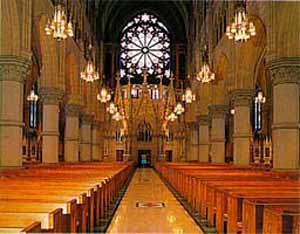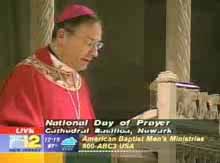 |
|

The church: Cathedral Basilica of the Sacred Heart, Newark, New Jersey, USA.
Denomination: Roman Catholic.
The building: In this context, there was something special which I noticed – perhaps "too obvious" to think of under other circumstances. Glancing about, one could see an entire cross section of the American public which Hollywood and television never capture. The cathedral is in a working class neighbourhood, in a city which has the highest crime rate in the United States, and where many are struggling merely to get by day to day. A glance about the congregation, and turning an ear to the few words exchanged, was poignant. Immigrants with the accents of many lands, others who would be the children of the immigrants of a generation ago, a number of fair skinned faces identifying those whose families once fled famine in Ireland. The cathedral itself was the work of 20th century immigrants, chapels to the various lands' patron saints flanking the high altar. The virtual montage, so in contrast to the silly stereotype of America as fabulously wealthy and absurdly optimistic, is quite a beautiful picture, and this is the community which is served by the cathedral.
The neighbourhood: Those unfamiliar with the geography of metropolitan New York City should know that Newark is directly across the river from lower Manhattan. Everyone present undoubtedly knew someone who had been working in the World Trade Centre when it collapsed three days before. Employees of the archdiocesan centre across the street had seen the disaster from the office windows. New York harbour, normally the site of tourist cruises and commuter runs, had military ships and ferries which were moving the dead to makeshift morgues on the other side of the river, and many of the injured to NJ hospitals.
The cast: Most Rev. Arthur Serratelli, regional bishop for Essex county, was the celebrant and homilist.
Eucharist for the day of National Prayer and Reflection.
How full was the building?
Extremely crowded – astonishingly so for a midday service on a Friday. A number of those in attendance were children in the uniforms of local Catholic schools and employees of the archdiocese (many of whom are not Roman Catholic).
Did anyone welcome you personally?
No – everyone was bustling in from the pouring rain outside, and the supply of leaflets was depleted because the turnout was so high.
Was your pew comfortable?
It was standard.
How would you describe the pre-service atmosphere?
Tense. Everyone undoubtedly is in shock from the devastation that hit the area a few days earlier, and fearful of the war ahead. People shared sad smiles, but most were on their knees, heads bowed, before the service began. Many had obviously been crying.
What were the exact opening words of the service?
The sound system was poor, so I could not make out every word, but there was a mention of being saved by Jesus's cross, and something about solidarity.
What books did the congregation use during the service?
One-page service sheet with the music for the service.
What musical instruments were played?
Organ – and the organist obviously was a highly accomplished musician. It is a shame that the musical selections were dreadful, and some of the tunes so weird that the congregation could have had no easy time trying to follow.
Did anything distract you?
The sound system not only carried little (I could not understand the bulk of the readings, petitions, or sermon) but had a good deal of static.
Was the worship stiff-upper-lip, happy clappy, or what?
The only word I can think of is bland.

Exactly how long was the sermon?
14 minutes. The sermon was delivered first in English, then Spanish, as is most suitable for this largely bilingual area. Too bad that, with the sound system so poor, I could not catch one word in five.
On a scale of 1-10, how good was the preacher?
It would be unfair to use a classification, since I could not hear most of what Bishop Serratelli was saying.
In a nutshell, what was the sermon
about?
I caught references to the book of Jeremiah and to the triumph of the cross. Of course, there was the expected reference to America as beacon of freedom and to solidarity, standard for any sermon delivered this week. For a movie of the sermon, click here.
Which part of the service was like being in
heaven?
There was nothing heavenly here – it was far too tragic an occasion, and the liturgy was too "flat" and simple for there to even be the comfort of richness.
And which part was like being in... er... the other place?
The entire atmosphere. Dedicated though those in attendance were, I'm sure, everyone is mourning the thousands of dead and frightened at what may be ahead. Everything shouted, "the world is at war."
What happened when you hung around after the service looking lost?
I left before the end – it was so crowded and stuffy that I could not breathe.
How would you describe the after-service
coffee?
No after service coffee.
How would you feel about making this church your regular (where 10 = ecstatic, 0 = terminal)?
The building is glorious, but the aesthetic sense ends there.
Did the service make you feel glad to be a
Christian?
It is always strengthening to see people at prayer – but I was too busy being glad that I was alive to think about anything else.
What one thing will you remember about all this in seven days' time?
As I exited, seeing the darkness of the sky, from the soot of the crumbled Twin Towers, I knew there were images that would remain in my mind till the day I died.
| The Mystery Worshipper is sponsored by surefish.co.uk, the internet service provider from Christian Aid. By offering email services, special offers with companies such as amazon.co.uk and smile.co.uk, surefish raises more than £300,000 a year for Christian Aid's work around the world. Click here to find out how to become a Mystery Worshipper. And click here if you would like to reproduce this report in your church magazine or website. Top | Other Reports | Become a Mystery Worshipper! © Ship of Fools 2001 |